Amano R.S., Sunden B. (Eds.) Computational Fluid Dynamics and Heat Transfer: Emerging Topics
Подождите немного. Документ загружается.

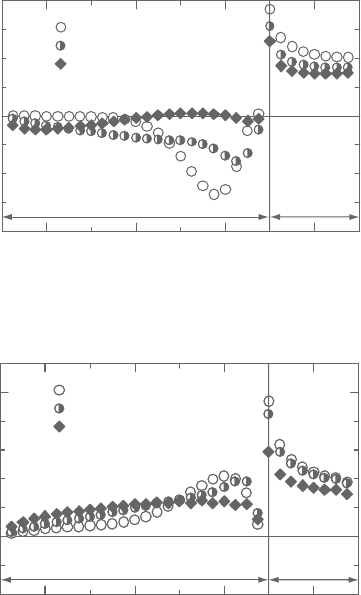
Sunden CH008.tex 10/9/2010 15: 19 Page 286
286 Computational Fluid Dynamics and Heat Transfer
Case 1 H = 0.2δ
Case 2 H = 0.1δ
Case 3 H = 0.05δ
Enclosure Rib
C
fr
/C
f0
−0.2
−4
0
4
0 0.2 0.4
x/d
Figure 8.7. Profilesoflocalskinfrictioncoefficientsaroundribalongthehorizontal
wall with x =0 at the middle of the enclosure.
Case 1 H = 0.2δ
Case 2 H = 0.1δ
Case 3 H = 0.05δ
Enclosure Rib
Nu
r
/Nu
0
−0.2
0
5
0 0.2 0.4
x/d
Figure 8.8. Profiles of local Nusselt number around rib along the horizontal wall
with x =0 at the middle of the enclosure.
the total drag is deter mined almost entirely by the pressure drag when the ratio is
within the range from 6 to 20.
From Figure 8.7, the local skin friction coefficient becomes minimum in the
enclosure and maximum at the front corner of the rib in Cases 1 and 2. On the
other hand, in Case 3, although the local skin friction coefficient takes the maxi-
mum at the front corner of the rib, both a large overall decrease and a local peak
in the enclosure cannot be seen; but it changes sign in the enclosure.The reattach-
ment point is located at x/δ =0.04; thus the forward flow region is observed over
0.04< x/δ < 0.21 until separation occurs in the enclosure between the ribs.
The local Nusselt numbers in Cases 1 and 2 distribute similarly to the abso-
lute value of the local skin friction coefficient. However, in Case 3, the Nusselt
number increases over the entire region in the enclosure. This situation is also
observed near the reattachment region of the backward-facing step flows [35], and
it is reported that the heat transfer coefficient reaches maximum there. Similarly,
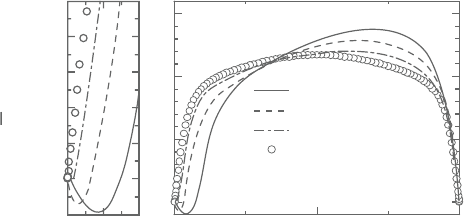
Sunden CH008.tex 10/9/2010 15: 19 Page 287
Recent developments in DNS 287
0.5
0.3
0.1
0
0.1
0.2
0
−0.1
U/U
m
0.5
1.5
1
0.1
0.2
0
0
0
12
Rough wall Smooth wall
Plane channel
Case 2 H = 0.1δ
Case 1 H = 0.2δ
Case 3 H = 0.05δ
y/δ
Re
t0
= 150
x/δ = 0
Figure 8.9. Profiles of mean velocity.
thelocalNusseltnumberincreasesinapproachingthereattachmentpointx/δ =0.04
and thefollowingforwardflowregion(0.04< x/δ < 0.21).From theabove results,
itisconfirmedthatinCase3,theheattransferispromoted,yetwithonlyarelatively
small increase in the drag.
8.5.3 Statistical characteristics of velocity field and turbulent structures
In a velocity field of a channel flow with a rib surface, the flow motions in the
enclosurebetweentheribsstronglyaffecttheflowfieldabovetheribs.Weexamined
thevariouswaysof averaging,e.g., averageoverthe x–z plane, spanwiseaverageat
themiddleoftheenclosure(x/δ =0)andattheribcrest(x/δ =0.4).Thedifferences
were not seen along the streamwise direction except near the roughness element.
Thus, in the following, the statistical quantities of turbulence in the middle of the
enclosure (x/δ =0) are discussed.
Figure8.9showsthemeanvelocitynormalizedbythebulkvelocityU
m
.Because
of the effects of the rib, the velocity decreases on the rough-wall side. The corre-
spondingdistributions oftheReynoldsshear stressandturbulentkineticenergy are
showninFigures8.10and8.11.Astheribheightincreases,turbulenceispromoted,
and both the Reynolds shear stress and the turbulent kinetic energy increase near
the wall. This affects the region over the center of the channel. However, in the
near-wall region of the opposite wall, there is only a small effect, in comparison
withtheresultsfortheplanechannelflow. Despitethenegativevalueofthevelocity
gradient near the wall in the enclosure as seen in Figure 8.9, the Reynolds shear
stress takes a positive value, thus confirming the occurrence of counter gradient
diffusion.BecausetheproductionoftheReynoldsshearstressismainlymaintained
with thepressure–strain correlation andthepressure diffusion, no production from
the mean shear is observed. An experimental study [29] indicated that the place
where the Reynolds shear stress becomes zero and the mean velocity becomes
maximum is different. However, the difference between them is very small; 2.0%,
2.8%, and 0.8% of a channel width for Cases 1, 2, and 3, respectively.
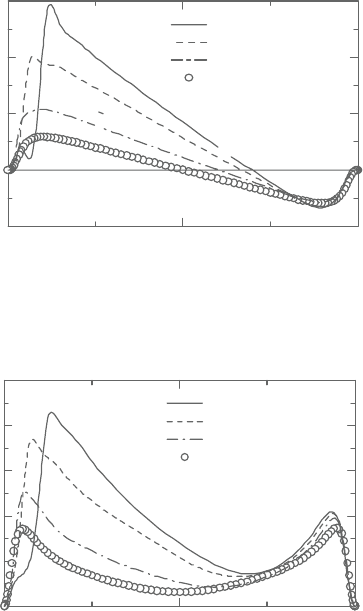
Sunden CH008.tex 10/9/2010 15: 19 Page 288
288 Computational Fluid Dynamics and Heat Transfer
−0.005
0
01
y/δ
2
0.005
un/U
m
2
0.01
0.015
Case 1 H = 0.2δ
Case 2 H = 0.1δ
Case 3 H = 0.05δ
Plane channel
Re
t0
= 150
x /δ = 0
Figure 8.10. Profiles of Reynolds shear stress.
0.01
0.02
01
y/δ
k/U
m
2
2
0.03
0.04
0.05
Case 1 H = 0.2δ
Case 2 H = 0.1δ
Case 3 H = 0.05δ
Plane channel
Re
t0
= 150
x /δ = 0
Figure 8.11. Profiles of turbulent kinetic energy.
Figure8.12 showsthe turbulence intensitiesnormalized by thefriction velocity
on the rough wall. In all cases, the statistical quantities get together well in the
upper region of the ribs. However, from Figure 8.11, the turbulence intensities
increase relative to the bulk mean velocity. The budget of the turbulent kinetic
energy is shown in Figure 8.13. In Case 1, the convection term is enhanced in
comparison with the planechannel flow.This is because the meanvertical velocity
component near the rib is increased, and also there is a variation in the turbulence
in the streamwise direction. Moreover, the contributions from the turbulent and
pressure diffusion terms are very large; in the enclosure between the ribs, there is
no turbulence production from the mean shear, but turbulent transport maintains
the turbulencethere. In Case3, the distributionof thebudget issimilarto theresult
in the plane channel, in comparison with Case 1, but the contributions from the
turbulent transport (turbulent and pressure diffusions) are large.
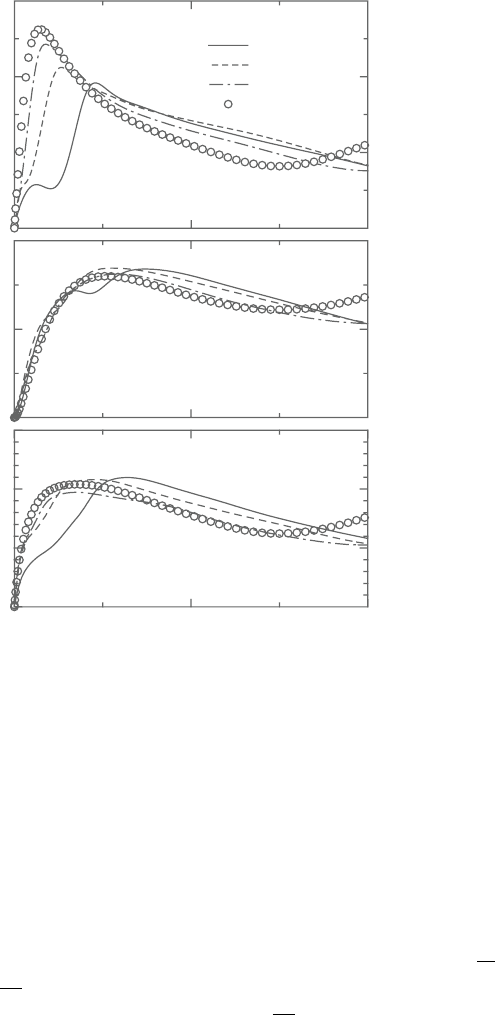
Sunden CH008.tex 10/9/2010 15: 19 Page 289
Recent developments in DNS 289
3
Rough wall Smooth wall
Case 1
Case 2
Case 3
Plane channel
Re
t0
= 150
v
+
rms
w
+
rms
u
+
rms
2
1
1
1
0.5
1.5
0.5
100 200
y
+
0
0
0
0
Figure 8.12. Distributions of turbulence intensities.
Next, to investigate the anisotropy of turbulence, Figure 8.14 shows the
pressure–straincorrelationtermsseeequation(23)whichareimportantinthenear-
wall region. The pressure–strain correlation is affected because the flow impinges
on the upstream side of the rib wall, and the pressure fluctuations increase over a
wide regionon the rough-wall sideincomparison with the smooth-wallside. Ifwe
compareCase1,wheretheribishighest,withtheplanechannelflow, therespective
components of the pressure–strain term become maximum in the region between
the ribs, and a very active energy exchange occurs. In Case 1, the sign of
11
becomes positive at y
+
15. In ordinary wall turbulence without external force,
it is observed that in the near-wall region, the splatting phenomenon caused by
v
2
gives the energy to w
2
as seen in the DNS results [16]. However, in the enclosure
between ribs, the energy does not redistribute to the
w
2
component. This can be
attributedto thetwo-dimensional vorticesexistingintheenclosure, whichpromote
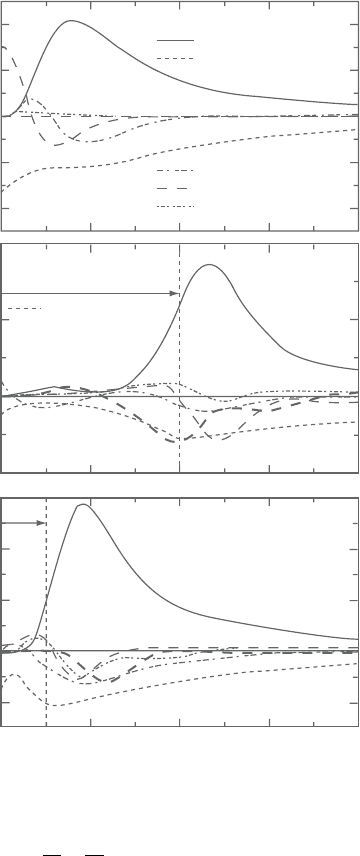
Sunden CH008.tex 10/9/2010 15: 19 Page 290
290 Computational Fluid Dynamics and Heat Transfer
Plane channel
Production
Dissipation
Turbulent diffusion
Viscous diffusion
Convection
In enclosure
(cavity)
Case 1 H = 0.2δ
Case 3 H = 0.05δ
Pressure diffusion
Re
t0
= 150
0.2
0.1
0
−0.1
−0.2
0.2
0.1
0
−0.1
0.3
0.2
0.1
0
0
0.1 0.2
y/d
0.3 0.4
−0.1
LOSS GAINLOSS GAIN LOSS GAIN
Figure 8.13. Budgets of turbulent kinetic energy.
the redistributionfrom the
v
2
to u
2
components.Asfor Case 3, theeffects fromthe
two-dimensionalvortexandthereattachmentarecombinedandtheyaffecttheredis-
tribution mechanism. As a result, as shown in Figure 8.12, in spite of the existing
roughwall,theanisotropyofturbulenceshowsbehaviorsimilartothatinthesmooth
wall, and the roughness promotes the heat transfer with a relatively small drag.
Finally, Figure 8.15 shows the streamwise vortices educed with the second
invariant tensors of the velocity gradient II [36, 37]. In each case, streamwise
vortices are produced in the region above the ribs on the rough-wall side, and
the structures spread over the region above the center of the channel. Moreover,
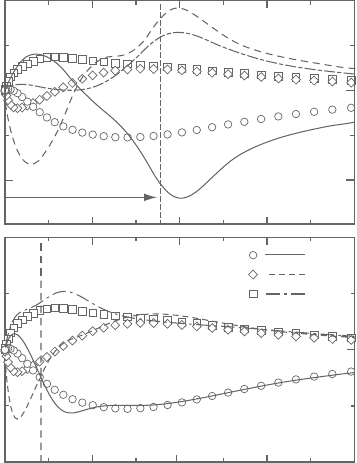
Sunden CH008.tex 10/9/2010 15: 19 Page 291
Recent developments in DNS 291
Case 1 H = 0.2δ
Case 3 H = 0.05δ
Inside of rib
0.1
0
−0.1
Φ
+
ij
0.1
0
−0.1
Φ
+
ij
Φ
11
Φ
22
Φ
33
20 40 60 800
y
+
Symbols: plane channel
Figure 8.14. Distributions of pressure strain terms in transport equations for
Reynolds stress.
if we compare Case 1 with Case 3, many more streamwise vortices are produced
in Case 1, where the rib effects are strong. In the enclosure between the ribs,
the streamwise vortices are seen in the whole region of the enclosure in Case 3.
However, in Case 1, because the flow stagnates downstream of the rib surface,
not many streamwise vortices are produced. This corresponds to the results of
the distributions of the skin friction coefficient and the Nusselt number as seen in
Figures 8.7 and 8.8.
8.5.4 Statistical characteristics of thermal field and related turbulent
structures
For the thermal field, the turbulence statistics at the middle of the cross-sectional
enclosure (x/δ =0) are discussed below. Figure 8.16 shows the mean temperature
distribution normalized by the temperature difference T
w
. The effect of the rib
causes the mean temperature to become asymmetric in all cases as for the mean
velocity profiles, and the temperature increases in the major par t of the channel.
On the other hand, because of the rough-wall side effects, the region of the large
temperature gradient extends to the smooth-wall side. Figure 8.17 shows the tur-
bulent heat flux in the wall-normal direction. The heat transfer is activated from
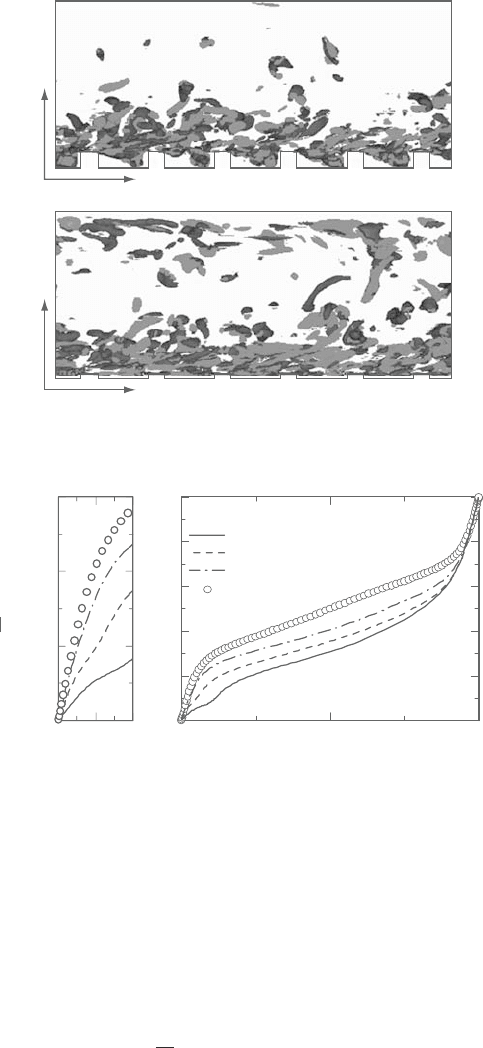
Sunden CH008.tex 10/9/2010 15: 19 Page 292
292 Computational Fluid Dynamics and Heat Transfer
x
y
x
Case 1 H = 2δ
Case 3 H = 0.05δ
y
Figure 8.15. Vortex structures visualized by second invariant: II
∗
< −0.5.
0.3
0.2
0.1
0.1
102
0 0.2
0.2
0.4
0.6
0.8
Plane channel
Re
t 0
= 150
Pr = 0.71
y /δ
1
Rough wall Smooth wall
Case 1 H = 0.2δ
Case 2 H = 0.1δ
Case 3 H = 0.05δ
Θ/∆T
w
Figure 8.16. Profiles of mean temperature.
the enclosure with the ribs, but in the thermal field also there are counter gradient
diffusions in Case 1.
Next, Figure 8.18 shows the rms intensities of temperature fluctuation, which
decrease on the rough-wall side, where the velocity fluctuations are promoted.
However, the temperature intensities increase on the smooth-wall side, where
the turbulent velocity fluctuation is suppressed. Apparently, the contrar y situa-
tions occur between the velocity and thermal fields on each side. To investigate
the cause and effect, we calculated the production and turbulent diffusion terms
of the transport equation for
θ
2
/2 see equation (11) in each case (Figure 8.19).
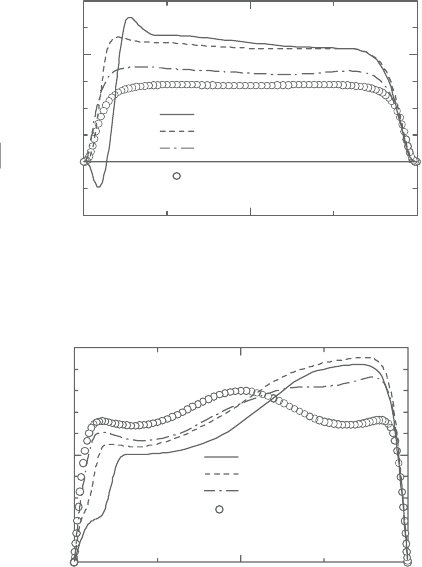
Sunden CH008.tex 10/9/2010 15: 19 Page 293
Recent developments in DNS 293
Case 1 H = 0.2δ
Case 2 H = 0.1δ
Case 3 H = 0.05δ
Plane channel
10
0
−v θ/U
m
∆T
w
0.002
2
Smooth wall
y/δ
Rough wall
Figure 8.17. Profiles of wall-normal turbulent heat flux.
Case 1 H = 0.2δ
Case 2 H = 0.1δ
Case 3 H = 0.05δ
Plane channel
Smooth wall
y/δ
120
0.05
θ
rms
/∆T
w
0.1
Rough wall
Figure 8.18. Profiles of rms intensities of temperature fluctuation.
The production terms on the smooth-wall side, where the temperature gradient is
large and the wall-normal heat fluxes increase, contributes greatly in the region
around the peak to the center of the channel. This is why the temperature intensi-
ties become large on the smooth-wall side. On the other hand, on the rough-wall
side, because the contribution from the production decreases and the turbulence
is maintained by the turbulent diffusion, the intensities of temperature fluctuations
decrease, especially in Case 1.
In order to examine the relationship between the velocity and thermal fields,
the distributions of the turbulent Prandtl number, Pr
t
, are shown in Figure 8.20.
The spanwise averaged Pr
t
at the middle of the enclosure and of the rib crest
are compared with that in the plane channel flow. Near the region above the rib,
Pr
t
becomes larger than that on the rib crest. However, it becomes smaller and
then becomes larger again in the enclosure. Thus, the turbulent Prandtl number
is not constant and the analogy between heat and momentum transfer cannot be
expected near the rib roughness. On the other hand, on the smooth-wall side, the
Pr
t
distribution well corresponds to that in the plane channel flow.
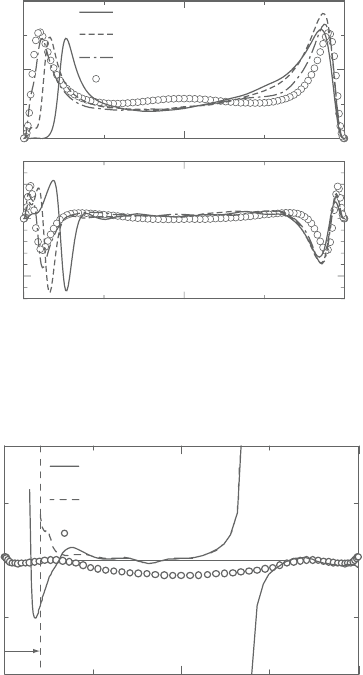
Sunden CH008.tex 10/9/2010 15: 19 Page 294
294 Computational Fluid Dynamics and Heat Transfer
0.02
Case 1 H = 0.2δ
Case 2 H = 0.1δ
Case 3 H = 0.05δ
Plane channel
0.01
Production
Turbulent diffusion
0
0.005
0
−0.005
01
y/δ
2
Figure 8.19. Production and turbulent diffusion terms in temperature variance
budget.
2
1
0
Pr
t
y/ δ
12
Spanwise average at the
middle of enclosure
Spanwise average at the
middle of rib crest
Plane channel
Case 1 H = 0.2δ
Rough wall Smooth wall
Rib
Re
t0
= 150
Figure 8.20. Turbulent Prandtl number.
Finally, to observe the spatial structures that contribute to the transport of the
passive scalar, Figure 8.21 shows the streamlines, which are spatially averaged
along the streamwise direction, and the temperature fluctuations in the y–z cross
section inthe plane channelflowand Case 1. Inthe plane channelflow, the stream-
lines show the streamwise vortices in the near-wall region; the sharp variations
in the temperature fluctuations associate with the vortices. On the other hand, in
Case1, large-scalevortexstructuresappear, whichextendtothecenter ofthechan-
nel from the enclosure between the ribs. With this vortex structure, the turbulent
mixing becomes larger in the center of the channel, and the turbulence transport is
promoted.This behavior is consistent with the above-mentioned statistical results,
i.e., theincreasein theheattransfer coefficient, thepronounced changeinthe mean

Sunden CH008.tex 10/9/2010 15: 19 Page 295
Recent developments in DNS 295
Plane channel Cooled wall
Heated wall
Smooth wall (cooled)
Rough wall (heated)
Rib
Case 1 H = 0.2d
y
z
Figure 8.21. Streamwise-averaged streamlinesandtemperaturefluctuationsin y–z
plane: θ/T
w
=−0.05 (white) 0.05 (black).
temperature distributions, and the increase in the turbulent diffusion terms in the
budget of temperature variance.
8.6 DNS of Turbulent heatTransfer in Channel Flow with
Arbitrary RotatingAxes: Spectral Method
In order to determine improvements in the modeled expression of rotating, wall-
boundedturbulentshearflows,DNSsoffullydevelopedchannelflowswithstream-
wise, wall-normal, and spanwise rotationare carried out using the spectralmethod
forthe15casesindicatedinTable8.5[18].DNSresultsofcasesforWNR1∼WNR5
and STR1∼STR5 are shown in Figures 8.22 and 8.23, respectively (Case 3 is not
shown here). In these cases, the spanwise mean velocity appears to be caused by a
rotationaleffect, whichincreaseswiththeincreaseinrotationnumberinbothcases.
Inparticular,withtheincreaseinthespanwisemeanvelocityofCase1,streamwise
mean velocity decreases due to the exchange momentum between the streamwise
and spanwise velocitites as in the following equations obtained from equation (5):
0 =−
1
ρ
∂
P
∂x
+
∂
∂y
ν
∂
U
∂y
−
uv
− 2W (17)
0 =
∂
∂y
ν
∂
W
∂y
−
vw
+ 2U (18)
